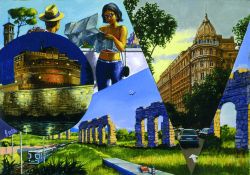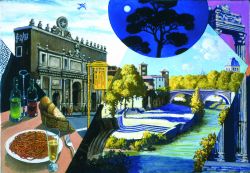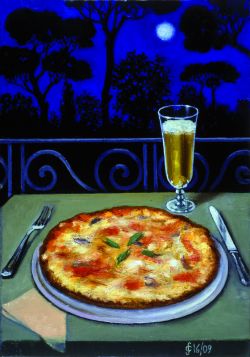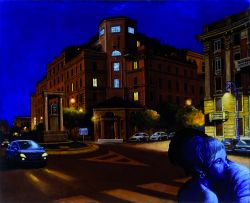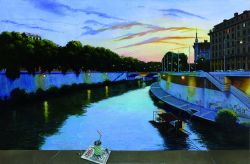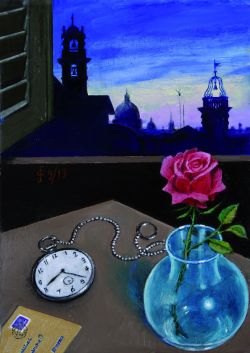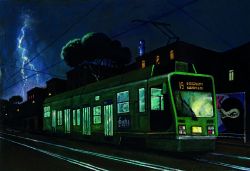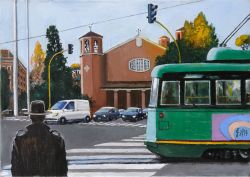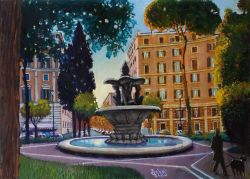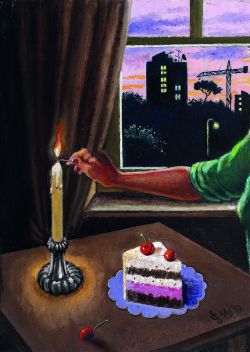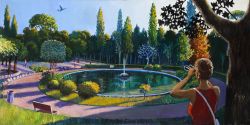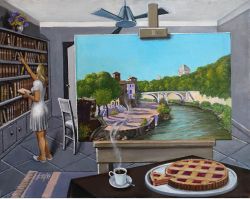Sergio Ceccotti
ROMA
Inaugurazione: mercoledì 4 marzo 2020 ore 18.30
Esposizione: 5 marzo - 20 luglio 2020
Orario d’apertura: lunedì-sabato 11-13/17.00-20 e su appuntamento lunedì mattina chiuso
La galleria 28 Piazza di Pietra presenta dal 4 marzo al 20 luglio 2020 Roma, una personale di Sergio Ceccotti.
In mostra sui due livelli della galleria oltre 20 dipinti tutti di ambientazione romana con un inserto dedicato al cibo, una selezione di quadri di piccolo formato raffiguranti appetitose pietanze di gusto tipicamente italiano.
Nel 1955 Sergio Ceccotti espone per la prima volta, a Roma nell’ambito di una mostra riservata all’arte giovanile. Prende così avvio un longevo e fecondo percorso artistico che lo porta ad acquisire e consolidare consensi e riconoscimenti in Italia e all’estero.
Un percorso che conduce ora Ceccotti alla Galleria 28 Piazza di Pietra con una personale che egli dedica a Roma: sua città per nascita ed elezione.
Le opere esposte sono testimonianza del patrimonio di suggestioni e influssi maturato nel corso di una vita artistica ricca di contaminazioni culturali e riferimenti pittorici.
Ceccotti non si propone solo di mostrare Roma attraverso scorci della sua “grande bellezza”, i suoi quadri divengono quasi le pagine di un racconto, i fotogrammi di un film che hanno la città e i suoi abitanti per protagonisti.
Al fascino delle ambientazioni esterne si accostano, a volte nella medesima opera, minuziose rappresentazioni di interni, in cui oggetti di norma “poco considerati” assumono un ruolo di rilievo. E c’è poi la frequente presenza umana ad accrescere la percezione che Ceccotti non stia affidando al nostro sguardo e alle nostre emozioni i luoghi di Roma ma la sua vita.
Come scrive la curatrice Eva Pedersen nel testo critico che correda la mostra: “I quadri di Ceccotti, prima di suscitare una coscienza intellettuale mediata che travalica la pittura, colpiscono per la loro bellezza. La bellezza misteriosa e segreta della vita quotidiana nella città più affascinante del mondo”.
Ulteriore riferimento alla quotidianità è inoltre fornito dal ricorso al tema del cibo. Attraverso una rappresentazione, particolarmente efficace, di piatti della tradizione Sergio Ceccotti arricchisce la mostra con un delizioso e attraente cammeo.
An exhibition of beautiful moments
by Eva - Kristin Urestad Pedersen
The first time I saw Sergio Ceccotti’s paintings was at an exhibition at the Palazzo delle Esposizioni. I’d gone because I was curious, I didn’t know Ceccotti and so didn’t quite know what to expect. But, as it sometimes happens when you visit different exhibitions in search of new stimulations, in an absolutely unexpected way, I found a series of paintings that immediately made a great impact on me.
Ceccotti paints Rome. He also paints Paris, he paints beaches and imagined places, but the paintings that struck me the most were his paintings of Rome.
These are, to be clear, images of a city, not an object or a monument. Few of his works depict very famous places or places that tourists typically visit, but that’s precisely why they are so quintessentially Roman. Ceccotti paints a Rome that is inhabited and lived. It is breathtakingly beautiful city but in Ceccotti’s world, this beauty derives not from monuments and narrow streets, but from the lives the Rome contains, daily lives: The afternoons at home, the return from work in the evening, the meals we eat...
I entered the Palazzo delle Esposizioni that afternoon and I ran out of words, I was speechless, silent like one of the protagonists in the paintings.
What struck me the most was this: I was in these works. Not me personally, but my life. I recognized everything, even places where I’d never been. This was my world. I remained in front of each painting for a long time, breathing the air of the location in the painting. It felt as if I already knew how it smelled.
Now, some time later, I’ve understood what it was with these paintings that made such an impression on me. I am a migrant, by choice I need to underline, but whatever the reason for leaving your home country is, when it’s done, when the train has departed or the airplane taken off, all migrants feel a certain emptiness, a hollow feeling in the chest somewhere. Where is Home now?
I’ve lived in Rome for many years, but I am and always will be a foreigner, and I am always on the outlook for confirmations of my belonging in Rome. The familiarity of the motives in Ceccotti’s paintings provided me with such a confirmation: Rome is Home. I live here. This is my city.
The emptiness is no longer there. It’s not an insignificant feeling, this.
Yet this significance is strictly personal. Ceccotti’s works seldom (or never?) have an explicit meaning, an objective which is deeper that what you see on the canvas, which is perhaps why these paintings lend themselves so easily to personal interpretations.
For the same reason, his painting can be of great value both to those that have lived in Rome all their lives and have an intimate relationship with the Ceccotti’s motives, as well as for tourists that perhaps ate an unforgettable pasta while they visited Rome, and see a Ceccotti painting as a tribute to that meal.
However, before setting out to look for whatever personal meanings these paintings may have, remember that not everything has a meaning that goes beyond the immediately provoked feeling. The work of Ceccotti, before it acquires a particular personal significance, an intellectually mediated message that goes beyond the painting itself, is striking because of its beauty. His works are sometimes inexplainable, mysterious, but they are always beautiful. He paints life, as habitual, intriguing, mysterious and beautiful as life can be.
The main question, therefore, is this: Are we ready to appreciate the beautiful moments without always looking for explanations or meanings or deeper truths?

